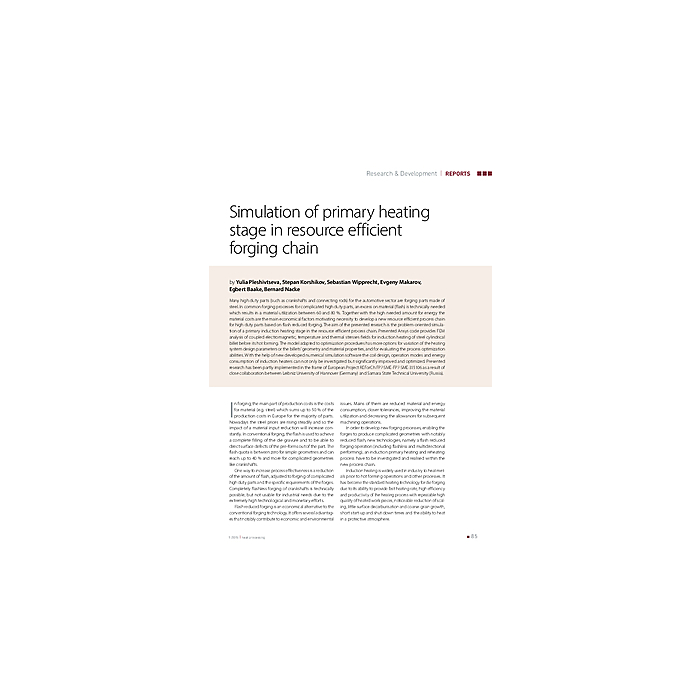Simulation of primary heating stage in resource efficient forging chain
€4.90
In stock
article number
00541_2015_01_08
Many high duty parts (such as crankshafts and connecting rods) for the automotive sector are forging parts made of steel. In common forging processes for complicated high duty parts, an excess on material (flash) is technically needed which results in a material utilization between 60 and 80 %. Together with the high needed amount for energy the material costs are the main economical factors motivating necessity to develop a new resource efficient process chain for high duty parts based on flash reduced forging. The aim of the presented research is the problem-oriented simulation of a primary induction heating stage in the resource efficient process chain. Presented Ansys code provides FEM analysis of coupled electromagnetic, temperature and thermal stresses fields for induction heating of steel cylindrical billet before its hot forming. The model adapted to optimization procedures has more options for variation of the heating system design parameters or the billets’ geometry and material properties, and for evaluating the process optimization abilities. With the help of new developed numerical simulation software the coil design, operation modes and energy consumption of induction heaters can not only be investigated but significantly improved and optimized. Presented research has been partly implemented in the frame of European Project REForCh FP7-SME-FP7-SME-315106 as a result of close collaboration between Leibniz University of Hannover (Germany) and Samara State Technical University (Russia).
| Authors | Yulia Pleshivtseva / Stepan Korshikov / Sebastian Wipprecht / Evgeny Makarov / Egbert Baake / Bernard Nacke |
|---|---|
| Publishing Date | 1 Jan 2015 |
| Format | |
| Zeitschrift | heat processing - Issue 01 2015 |
| Publisher | Vulkan-Verlag GmbH |
| Language | English |
| Pages | 6 |
| Title | Simulation of primary heating stage in resource efficient forging chain |
| Description | Many high duty parts (such as crankshafts and connecting rods) for the automotive sector are forging parts made of steel. In common forging processes for complicated high duty parts, an excess on material (flash) is technically needed which results in a material utilization between 60 and 80 %. Together with the high needed amount for energy the material costs are the main economical factors motivating necessity to develop a new resource efficient process chain for high duty parts based on flash reduced forging. The aim of the presented research is the problem-oriented simulation of a primary induction heating stage in the resource efficient process chain. Presented Ansys code provides FEM analysis of coupled electromagnetic, temperature and thermal stresses fields for induction heating of steel cylindrical billet before its hot forming. The model adapted to optimization procedures has more options for variation of the heating system design parameters or the billets’ geometry and material properties, and for evaluating the process optimization abilities. With the help of new developed numerical simulation software the coil design, operation modes and energy consumption of induction heaters can not only be investigated but significantly improved and optimized. Presented research has been partly implemented in the frame of European Project REForCh FP7-SME-FP7-SME-315106 as a result of close collaboration between Leibniz University of Hannover (Germany) and Samara State Technical University (Russia). |
Write Your Own Review

